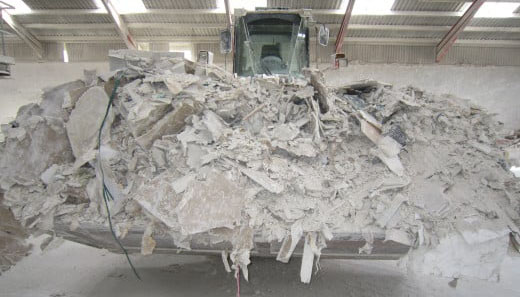Gypsum waste
ACA crushers
Recycling of gypsum waste from demolition and recycling stations
We are a crusher manufacturer who manufactures customized machinery for recycling gypsum waste and residue. The machine crushes recyclable gypsum, gypsum residue, gypsum waste from demolition and gypsum collected from recycling centers and renovation sites.
The gypsum crusher/mill crushes the gypsum and separates it from paper, insulation materials, steel rods, plastic, wood, cables, nails and screws for subsequent removal. After removing the paper, insulation materials, steel rods, wood, nails, screws, cables, etc., the gypsum can be reused to produce new plasterboards.
The gypsum mill manages to crush the gypsum without creating paper contamination in the final gypsum product.
The Gypsum crusher is very cheap in operation, is suitable for continuous 24/7 operation and has a large capacity.
Recycling of gypsum from recycling centres
The crushing machine for recycling of gypsum waste and gypsum residue from recycling stations and collection points for improved recycling.
We customize all hoppers to fit your requirements to ensure that the waste easily can be fed, via a digger or a conveyor belt, to the crushing machine.
A gypsum mill for recycling of gypsum waste
The gypsum mill crushes the gypsum and separates it from foreign bodies such as paper, insulation materials, steel rails, plastic, wood, nails and screws, which will subsequently be removed.
Slow-turning machine for effective gypsum crushing
The ACA gypsum crusher is a slow-turning machine operating at 15 RPM per minute with a torque of 13,000 newton metres per screw, even at this low number of revolutions. The gypsum crushing is no hassle for our machines.

Input: raw material of gypsum waste getting loaded onto the gypsum crushers conveyor belt.
Effective milling machine for gypsum recycling
To optimize the subsequent screening of the gypsum waste the crushing machine is designed to produce an even flow of the gypsum waste to suit the rest of the production process.
Safe and reliable crusher for milling of gypsum waste
With a substantial weight of up to 20 tonnes, a torque of 13,000 newton metres and reverse operation in the event of excess current, breakdown of the crusher can be avoided, and many years of useful life and safe, reliable operation in the company is assured.
Cheap in operation
The moveable parts of the gypsum crusher do not touch each other, which guarantees a long useful life of the parts, as the gypsum residue is crushed against itself, thereby separating the gypsum from the paper and metal components, which will be sorted later.

ACA gypsum crusher/mill machine in operation. Crushing the raw material into finer output.
Size of the output from recycled gypsum waste is easily regulated
The gypsum waste crusher has a very flexible design which makes it easy for you to regulate the size of the output material. This is done by adjusting the rotating knives.
The knives are also very easily replaced.
Unpolluted crushed gypsum
The gypsum mill manages to crush the gypsum without creating paper contamination in the final gypsum product, so it can later be reused to make new plasterboards.
Adjustment to requirements
A gypsum crusher can be adapted to the customer’s requirements so that the machine is supplied in the size that is most economical for the customer and best suited for the task at hand. The crusher is designed to operate around the clock, so it is an advantage to choose a machine that will allow you to maximize the use of the capacity for as many hours as possible. In other words, there is no reason to choose the biggest model with 12 screws if you can use a smaller model. Conversely, a small model can be extended if the need for capacity increases.
Recycling is in keeping with the times
It is in keeping with the times to maximize the recycling of gypsum waste. In its guiding opinion from autumn 2015, the Danish Environmental Protection Agency recommends, among other things, that gypsum be recycled or reused.
The difference is whether the gypsum is crushed before being reused or whether the plasterboard can be used as-is for a different purpose.
In addition to being used for new plasterboards, the crushed gypsum can also be used in the production of cement. It can also be used in compost or for screening purposes.
Studies performed by the Danish Environmental Protection Agency show, however, that the best environmental profile is obtained by using the crushed gypsum for new plasterboards or in the production of cement.
Reused gypsum material
The gypsum material is a natural material that is mined in countries in its original form. A large part of the gypsum used for plasterboards in the industrial sector nevertheless comes from cogeneration plants.
These plants produce gypsum material when using lime to clean and neutralize the smoke. This gypsum can then be used in the production of plasterboards at the factories.
Another feature of gypsum is that used plasterboards, cut-offs, and other gypsum waste, for example from demolition work, can be crushed and used again in the production of new plasterboards.
Plasterboard is thus a natural product which, in addition to forming part of the life cycle of new gypsum products, can also help reduce the environmental impact from cogeneration plants.
The crushers for gypsum products play an active role in this recycling process. The crusher is relevant both at recycling centers, where plasterboards are collected and the raw material can be supplied to plasterboard factories and at demolition companies that sell various fractions.
Crushers are also used at various plasterboard factories to crush faulty products or unsaleable gypsum residue without having to transport the plasterboard to an external demolition company.
Back to ACA crushers